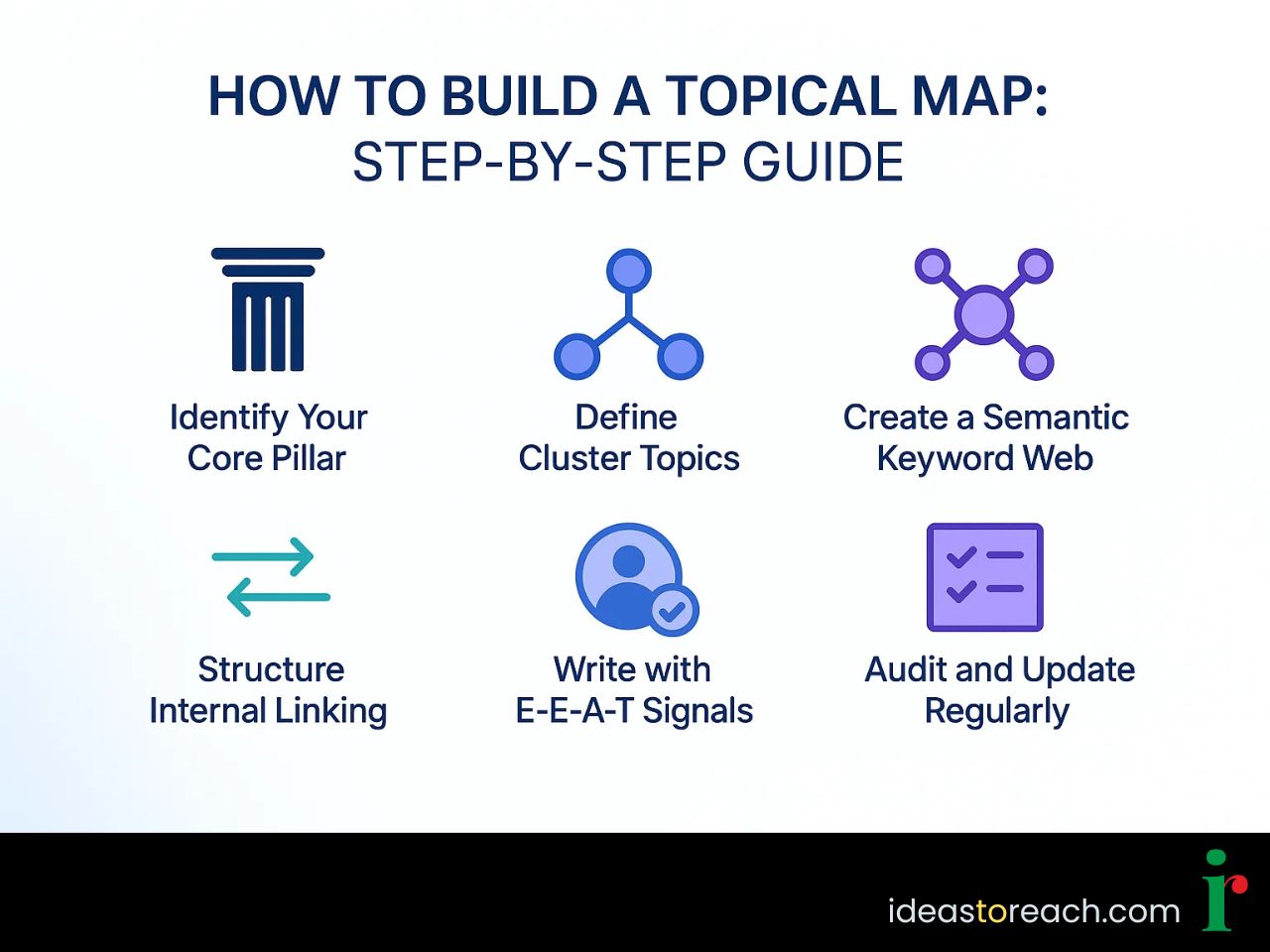
In today’s AI-driven search landscape, SEO success is no longer achieved by chasing individual keywords. Search engines now prioritise depth, context, and topical coverage. Building SEO authority means demonstrating knowledge across an entire subject area as showing Google that your website understands, explains, and connects all relevant aspects of a topic.
This shift has made topical map SEO an essential part of every modern content strategy. It organises subjects into structured clusters, creating meaningful content relationships and improving ranking signals. By visually connecting pillar pages with related subtopics, brands can grow faster, rank higher, and stay relevant.
At Ideas To Reach, we’ve seen topical map strategies revolutionise SEO performance for Indian businesses. Our experience shows that structured maps attract visibility and helps to build trust, authority, and lasting search impact beyond traditional optimisation approaches.
A topical map is like a blueprint for your content ecosystem. It connects the dots between your main pillar topics, related subtopics, and supporting content clusters, ensuring every page contributes to the same overarching theme.
Unlike old-school keyword targeting, a topical map SEO approach focuses on semantic relevance and contextual authority. For example, if your primary pillar page is about “SEO services India,” your clusters might include subpages such as “local SEO strategy,” “on-page optimisation,” and “technical SEO guide.” Together, they form a topic cluster model that communicates topical depth to Google.
This structured map helps search engines identify you as a subject matter expert as someone who not only targets relevant keywords but also demonstrates real understanding through content breadth and depth.
Google’s ranking algorithms increasingly depend on semantic relationships, entity-based optimisation, and topical authority signals. The search engine no longer rewards random, standalone blogs, as it values clear content architecture and knowledge graph patterns that demonstrate expertise and authority.
By using topical maps for SEO, you can:
Strengthen your site’s authority by providing consistent coverage of relevant subjects.
Enhance discoverability and impressions across semantically-linked keywords.
Enhance internal linking strategy for improved navigation and enhanced contextual relevance.
Build a longer-lasting SEO foundation that aligns with Google’s E-E-A-T principles.
At Ideas To Reach, we use topical mapping frameworks as part of our Search Sequence SEO strategy to ensure your brand consistently ranks for competitive and informational queries.
Learn more about this structured method in our detailed Search Sequence SEO strategy guide.
Building a topical map might seem complex, but with a systematic process, it becomes a powerful content management blueprint.
Choose a main topic that aligns with your brand’s expertise and audience intent. For instance, a pillar could be “SEO for real estate businesses in India” or “Elderly care marketing strategy.”
This page will serve as your content pillar, anchoring all related cluster topics.
Next, list semantically related subtopics or topic cluster maps that support your pillar. These could include blogs like “local SEO for realtors,” “keyword research framework,” or “Google Business optimization for real estate.”
Use keyword research tools or AI content planners such as Surfer Topical Map tool or Google’s keyword planner to map out related entities, synonyms, and semantic search patterns. Ensure you understand user intent, not just search volume.
Connect each cluster back to the pillar using hyperlinks and descriptive anchor text. This relationship enables search crawlers to navigate your knowledge network effectively.
Explore more details in our internal linking guide for SEO success.
Demonstrate Experience, Expertise, Authoritativeness, and Trustworthiness across every page. Mention your real-world experience, cite credible data, and maintain clarity. Learn how E-E-A-T strengthens SEO in our resource on E-E-A-T and topical authority connection.
SEO evolves fast. Keep analysing your content map for expired links, outdated pages, or underperforming topics. Update cluster pages with newer insights or statistics to maintain search relevance.
This step-by-step topical map building guide for SEO helps not only global businesses but also Indian brands aiming for better authority and visibility in 2025.

A keyword list is valuable, but it lacks structure. It simply tells you what users are searching for.
A topical map SEO approach, however, reveals how those searches are connected. It identifies clusters, link opportunities, and supporting pages that make your topic stronger.
In 2025, entity-based optimisation and semantic SEO are reshaping how content ranks. Keywords alone can’t establish expertise. A topical map indicates to Google that your site provides comprehensive, interconnected coverage of a topic, which directly impacts topical authority and enhances long-term rankings.
For Indian brands or agencies, a topical map framework must strike a balance between global best practices and local context.
At Ideas To Reach, we’ve observed that Indian businesses often aim to target both regional and international audiences. Our approach includes:
Mapping content around localised entities (e.g., “SEO services Chennai,” “digital marketing agency India”).
Creating geo-targeted content clusters to appear in both regional and national SERPs.
Employing entity linking and local schema markup to strengthen signals in Google’s knowledge graph.
Agencies that leverage these strategies achieve more in-depth topical coverage more quickly. This not only boosts local visibility but also positions their clients as specialists within a niche.
Looking for expert guidance? Our team at the best SEO agency in Chennai can help design your next content and topical map strategy for growth.
Topical maps are at the heart of the cluster content strategy. From planning your content calendar to mapping internal connections, everything stems from your site’s structural design.
Some best practices for topical maps in content strategy in India include:
Creating distinct cluster pages for different audience segments.
Ensuring every piece of content answers a specific query related to your pillar.
Using consistent anchor texts and semantic linking.
Leveraging AI analytics to discover topical gaps faster.
Tracking performance metrics, including impressions, dwell time, and engagement, for iterative improvements.
Ultimately, topical map SEO gives your content purpose and direction. It aligns your publishing plan with how both users and AI search systems understand information.
For businesses aiming to turn SEO rankings into business revenue, contact our expert professionals today!
Even a great topical map can fail if poorly executed. Avoid these pitfalls:
Treating topical maps as static documents instead of evolving frameworks.
Ignoring user intent alignment when assigning cluster topics.
Lacking consistent internal linking patterns.
Over-prioritising keywords without semantic depth.
Failing to refresh content based on new user search trends.
Read about how to avoid similar pitfalls in our common SEO mistakes to avoid guide.
Search algorithms are advancing toward intent recognition and AI-driven ranking models. This makes semantic SEO and topical maps indispensable tools in 2025 and beyond.
As we guide clients using proven frameworks, our focus remains on connecting human understanding with machine-readable content. It’s about building depth instead of chasing fleeting keywords.
Indian brands adopting topical maps now will stay ahead in 2026’s SEO race. For more on forward-looking strategies, explore our realistic SEO strategy guide for 2026 or insights on the future of SEO careers.
A topical map is a structured content blueprint that organises your website’s pages around a core topic and inter-linked subtopics, showing search engines you cover a subject thoroughly. It goes beyond single keywords by mapping clusters of related content that reinforce authority.
By connecting cluster pages through internal links and content relevance, topical maps effectively showcase the depth and expertise of each topic. This structure sends strong authority signals to Google, enhancing your overall domain strength.
Begin by defining your main pillar topic, researching related subtopics, arranging them into hierarchical clusters, and establishing strong internal linking. Regularly update the structure to keep content relevant and authoritative.
Yes. Local businesses can build topical maps around niche subjects, such as “SEO services India”, while optimising subtopics for regional intent. This strategy enhances visibility in both local and national search results.